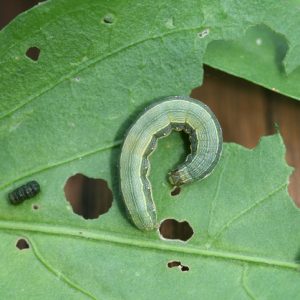AUBURN UNIVERSITY, Ala. – As the vegetable crop growing season continues, there is a heightened risk for many insect pests. Currently, Alabama Cooperative Extension System entomologists are seeing a drastic increase in armyworm moth numbers. This makes the need for regular scouting measures that much more important.
There are four armyworm species commonly seen in Alabama: Southern armyworms, beet armyworms, fall armyworms and yellowstriped armyworms. Ayanava Majumdar, an Alabama Extension entomologist, said populations of Southern armyworms are growing, and beet armyworms are more than likely coming soon.
“Recently, I have noticed a sharp increase in Southern armyworm moth numbers,” Majumdar said “Beet armyworms are usually not too far behind Southern armyworms on crops this time of year, especially on small specialty crops or transplants.”
Armyworm caterpillars are especially threatening to small and weak outdoor plants. Majumdar said their first method of attack is going after the leaves on a plant.
“In fields, the damage from armyworms feeding on the leaves will start in certain hot spots, but then it seems to increase and spread in a few days,” Majumdar said. “In high tunnels, this damage spreads like a wildfire.”
After eating the leaves, the caterpillars will also cause damage to unripe and ripe fruits.
“The damage on the fruit will appear as round holes, often on top of the fruit,” Majumdar said. “After making these holes, the caterpillars may enter the fruit and feed inside.”
The egg-laying moths are big threats to larger plants that are in an enclosed environment, such as a high tunnel or greenhouse.
Scouting
When it comes to scouting, Majumdar said there are several signs to look for.
“Growers should check for armyworm caterpillars underneath the leaves, and check for egg masses on soft leaves and stem terminals,” Majumdar said.
When scouting for the caterpillars, it is best to look during the cooler parts of the day. This is when they will be actively feeding. Majumdar also encourages producers to scout after bad weather and storms.
Control and prevention
In the event of an armyworm infestation, there are several chemical control options available for both home gardeners and commercial growers. Majumdar recommends that home gardeners and small farmers consider using an organic insecticide for control.
“The majority of organic insecticides are easily available through online vendors and farm supply stores scattered around the state, making them a great choice for home gardeners and small farmers,” Majumdar said.
Some organic insecticide examples include Bacillus thuringiensis (XenTari and DiPel), natural pyrethrin (PyGanic and Azera), spinosad (Entrust), neem with azadirachtin (Neemix) and Bacillus thuringiensis plus a disease control premix (LEAP). Growers should apply these products at three-to-five-day intervals in high-pest pressure situations.
For conventional farmers, synthetic insecticide options include pyrethroids, chlorantraniliprole (Coragen), insect growth regulators (Intrepid and Rimon), Spinosad (Radiant) and carbaryl (Sevin).
“When applying any chemical product, always make a fresh solution for each application and follow all insecticide labels,” Majumdar said. “Also, develop an integrated pest management plan, record the product’s effectiveness and rotate insecticides to protect natural enemies.”
While controlling a current infestation is important, it is also important to plan for next year’s pests. Majumdar said making plans to implement a pest exclusion system will help with pest control next year.
“Pest exclusion systems–both permanent and temporary types–are extremely effective at blocking moths and reducing the overall number of armyworm caterpillars early in the growing season,” Majumdar said.
More information
The Extension Brief Temporary and Permanent Pest Exclusion Systems for Vegetable Production provides an excellent discussion of the benefits of each type of system. Visit www.aces.edu to learn more.


























